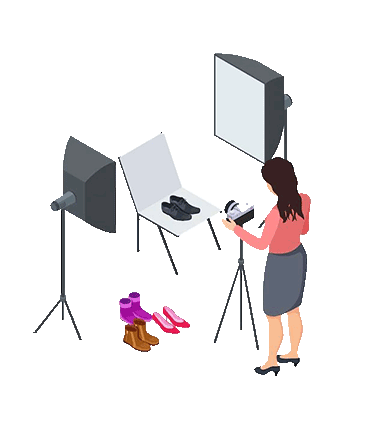
Amazon Image Requirements
In this Amazon Image Requirements guide:
- Amazon Image Requirements
- How to Design Product Images
- How to Edit Amazon Images
- Amazon Image Policy
Amazon Image Requirements: Chapter 1

This first chapter will teach you the basics of Amazon’s image requirements.
You will love this chapter if you’re a beginner unsure where to start.
Later, we will dig deeper into how to make product images, and I’ll show you examples of best practices.
But for now, let’s start with the fundamentals.
The Amazon image requirements provides strict guidelines for FBA sellers about their Amazon images.
What size should an Amazon product image be?
The best product image size for Amazon is 2000×2000 pixels, with an aspect ratio of 1:1.

With these optimized dimensions, Amazon allows for maximum zoom.
Even if you can’t make this exact size, you should adhere to the following rules:

- The minimum and maximum Amazon image dimensions for the longest side are between 500 pixels – 10,000 pixels.
- It is recommended to use dimensions larger than 1000 pixels on one side.
- Image zoom abilities start when the image is at least 1000 pixels on the longest side and 500 pixels on the shortest.
- The maximum file size is 10MB per image.
- Allowed file formats: JPEG, TIFF, PNG, and GIF (Recommended: JPEG).
- Crop your photo well to maximize product size and limit the white space.

What are Amazon Image Requirements? (2024)
Now, let’s go deeper into the technical side of Amazon image requirements in 2024.
Every detail page in the Amazon store requires at least one product image, and they recommend providing six photos and one video.
The first image on the product detail page is the “MAIN” image, which is shown to customers in search.
The MAIN image must only show the product you are selling on a white background, and the product needs to fill the image frame.
The additional Amazon images can show the product in use or its environment. Try to use different angles and features.
Product images site standards:
- The Amazon images must accurately represent the product for sale.
- Your Amazon images need to match the title of your product.
- Your product must fill 85% of the image or more.
- The optimal zoom experience for detail pages requires files to be 1600px or larger on the longest side. Zoom has been shown to help enhance sales.
- Your image must be in-focus and professionally lit. It cannot be blurry or pixelated.
- No nudity or sexually suggestive images are allowed. Kids, baby leotards, underwear, and swimwear must not be shown on a human model.
- Don’t include any Amazon logos, badges, or trademarks on your images. This applies to all Amazon products, such as Alexa, Prime, or Amazon Smile.
Product images site standards for the main picture:
- As mentioned, MAIN Amazon images must have a pure white background, but try to minimize the white space. – RGB color values of 255, 255, 255.
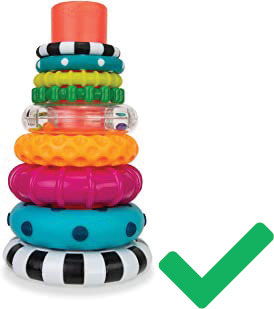
- You need to use professional photographs of the actual product. Graphics and illustrations won’t be accepted. Refrain from using any accessories or props that might be confusing for customers.
- Do not include text, logos, borders, color blocks, watermarks, or other graphics on your MAIN image.
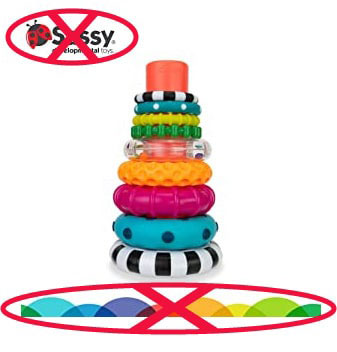
- Only use one view of a single product for your MAIN image, and make sure it is of the entire product.
- Amazon images need to be outside of their packaging.
- If you use a person to showcase your product, the model must stand. No sitting, kneeling, or lying down.
- MAIN images for Women’s and Men’s clothing must show the product on a human model or lying flat on a surface. Invisible mannequins are acceptable as long as the product is not obscured.
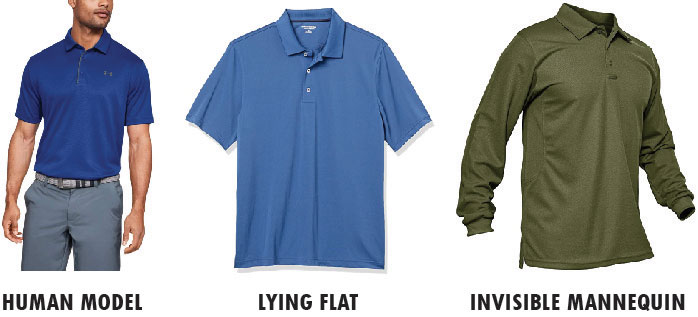
- MAIN images must not show Kids & Baby clothing on a human model. They must be shown lying flat on a surface or using an invisible mannequin as long as the entire product remains visible.
- MAIN images of shoes must show a single shoe facing left at a 45-degree angle.
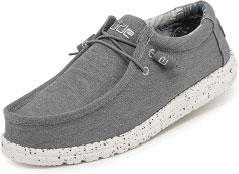
You can read the official Amazon Image Requirements 2024 here. To find a list of product category-specific image standards, head to the Product page style guide.
Main Image Basics
The main product image is the first representation of your product that customers see, making it highly relevant in their purchasing decisions. Here are some of the essential technical requirements for the main image:
- Image size: The minimum image dimension should be 500px on the longest side, and the maximum allowed is 10,000px. However, having at least 1,000px is recommended for enabling zoom; ideally, aim for 1,600px or more on the longest side for better zoom images.
- File format: Accepted file extension formats include JPEG (.jpg or .jpeg), TIFF (.tif), PNG (.png), and GIF (.gif), with JPEG being the preferred format.
- White background: Main product images must have a pure white background (RGB values of 255,255,255) to avoid distractions or unnecessary elements.
Additionally, it’s vital to ensure that Amazon images are not blurry, pixelated, or have jagged edges and must not contain nudity or be sexually suggestive.
What is the best aspect ratio for Amazon photos?
Since I promised to start at the basics, let’s first cover the aspect ratio. It is two numbers divided by a colon that refers to the proportional relationship of the width of an image to its height. The first number is the image’s width, and the second is the height.
The optimal image aspect ratio can help ensure your Amazon product image is framed optimally. This will influence how your product will look in the thumbnails.
The widest image ratio you can use for Amazon is 5:1, but as mentioned earlier, a 1:1 ratio is your best choice, if available.
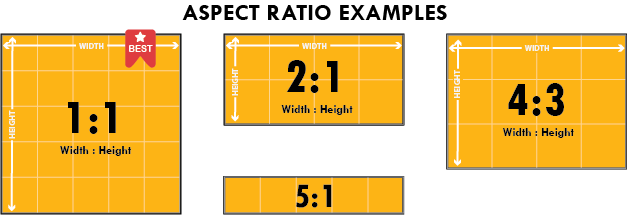
Amazon listing image Guideline
So, we already covered that you can use up to six images for each of your listings, and you now know the Amazon image requirements for your main and secondary images.
You can upload a photo for your listing on Amazon in three ways.
- Sell on Amazon: Upload your image through the Sell on Amazon page in the Photos section. All sellers are allowed to do this.
- Seller Central: Ass a Product tool in Seller Central. You can use the “Add Product” tool to do this. To add photos of an item for a specific listing, go to the Photos of your item section on the Offer tab.
- Listings Loader tool: Only Professional sellers have access to the Listings Loader tool.
For the official guidelines, head over to the Listing Photos page in Seller Central.
Before submitting your image files, here is a summary of what you need to look out for:
| Photo Requirement | List Single Items | Book Loader Feeds |
| Accepted File Types | JPEG (.jpg) and GIF (.gif) | JPEG (.jpg) and GIF (.gif) |
| Maximum File Size | 10MB | 10MB |
| Image Resolution | 72 pixels per inch | 72 pixels per inch |
| Minimum Dimensions* | 200 x 200 pixels | One side must be at least 200 pixels but the other may be less |
| Maximum Dimensions* | 2000 x 2000 pixels | 10,000 x 10,000 pixels |
| Maximum Dimension Ratio* | 5 to 1 (2:1 or 1:1 preferred) | 5 to 1 (2:1 or 1:1 preferred) |
Amazon Image Guidelines
Amazon allows sellers to add multiple additional images, providing multiple angles and views of the product. These Amazon images can showcase different use cases, lifestyle images, or off-model pictures to enhance the customer’s understanding of the product. Here are some essential guidelines for additional images:
- Show the entire product: Ensure each image displays the entire product so that customers can understand its size and shape accurately.
- Multiple angles and views: Utilize this opportunity to show close-ups, different angles, and various product features to better understand your product.
- Lifestyle images: Incorporate images of your product used in real-life situations to help customers relate to the product and understand its benefits.
In conclusion, being attentive to Amazon’s product image requirements and appealing to potential customers is crucial for maximizing sales. Implementing the given technical requirements and guidelines ensures a better chance of success for sellers navigating the competitive Amazon marketplace.
Amazon Image Requirements For Different Product Categories
When creating a product listing on Amazon, paying attention to the specific image requirements for each category is essential. Amazon has set these requirements to maintain a consistent and high-quality shopping experience for customers. This section provides an overview of special image requirements for different product categories, including oversized and beauty products.
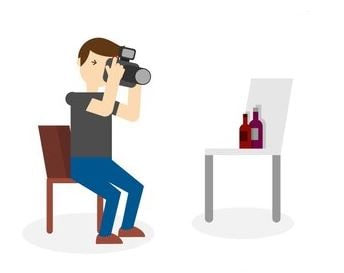
For the oversized product category, it is crucial to capture the scale of the item to provide an accurate representation for the customer. A person or a size reference object should be included in the image to establish the actual size of the product. The image should be at least 1,600px on the longest side to take advantage of Amazon’s zoom feature, which enhances sales. Properly showcasing an oversized item ensures it meets Amazon’s image guidelines and avoids the rejection of the listing.
In the case of beauty products, images play a vital role in showcasing the usage and benefits of the item. Ideally, close-up shots should be taken of individual products to highlight their unique features. It is essential to ensure that the details on the packaging, such as ingredients, safety warnings, and usage instructions, are visible. Using before-and-after images is also highly effective in presenting the product’s effectiveness.
Amazon image requirements for different categories ensuring that all images, including Amazon product photos, meet specific image and photo requirements to align with Amazon’s standards.
Different product categories may have unique requirements, so it is essential to review Amazon’s guidelines for each category. For instance, clothing items often need a standardized layout with a white background and a clear presentation of the garment’s shape. Similarly, electronic items require images that display essential features and connections alongside the product’s overall design.
In summary, understanding and following the special image requirements for each product category is essential when creating Amazon listings. Doing so will help ensure that your products are presented in the best possible way, providing clear and accurate information to potential customers and ultimately increasing the chances of successful sales.
Images for Amazon Design: Chapter 2
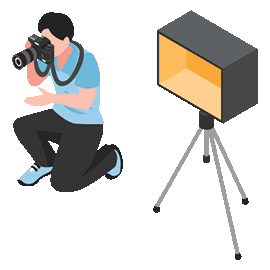
This part teaches you how to make eye-catching images for your Amazon items.
I’ll also give you some examples of the best Amazon product images.
If you are unsure where to get your product photos, this chapter can help you.
How do you make product images for Amazon?
You need to make sure that your images for Amazon are high quality and crystal clear.
Not only because of Amazon’s product image requirements but because you must stand out amongst all the other sellers.
A blurry photo made with your phone won’t cut it.
Make sure to use professional lighting, a good camera, and a high resolution.
Main Image
Your main image is the most important. This is what will lure people to your listing. Make sure that this meets all the requirements. Take your product photo with a clear white background, and make sure the product fills at least 85% of the whole picture.
You should maximize the space you get from Amazon.
Use the other five images to show your product from different angles in various scenarios.
You can even use graphics in these Amazon images if you want to.
The most critical aspect of standing out from the crowd is creating original, interesting, and excellent-quality images for Amazon.
Images for Amazon Good examples
Here are a few examples of the perfect main product shots.
As long as you are true to the product, not trying to deceive, and keeping to high standards, you shouldn’t have a problem.
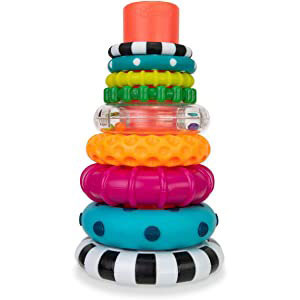

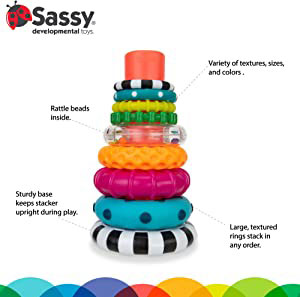
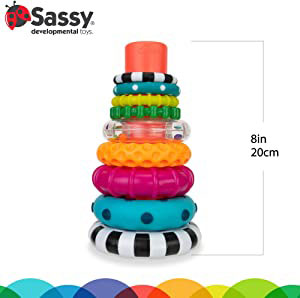


Images for Amazon Bad examples

Photography Techniques for Amazon Products
Product photography plays a significant role in attracting customers and increasing sales on platforms like Amazon. Therefore, it’s crucial to understand and apply appropriate techniques to create high-quality product images. Some effective approaches include using the right camera, experimenting with angles, perfecting lighting, using a tripod, and considering professional photographs when necessary.
The choice of camera can significantly impact image quality. A DSLR or mirrorless camera is often recommended due to its versatility and ability to capture high-resolution images. These cameras allow you to adjust settings such as aperture, shutter speed, and ISO to achieve optimal results.
Angles play a vital role in showcasing different aspects of the product. Multiple angles ensure that customers can view every feature and detail. Experimenting with various angles may reveal the best perspective to highlight the product’s unique selling points.
Lighting is another crucial aspect of product photography. Natural light should be used when photographing products, as it provides a more realistic representation of colors and textures. However, if natural light is not an option, using a lightbox or softbox can create a similar effect. The light should be diffused to avoid harsh shadows and glares that can negatively impact image quality.
Utilizing a tripod ensures stability and sharpness in your product photos. Tripods eliminate camera shake, allowing you to capture crisp images with consistent framing. This consistency is crucial when presenting a professional look on your Amazon product page.
In some cases, hiring a professional photographer or an agency to handle product photography may be beneficial. Professionals with specialized knowledge, experience, and equipment can result in top-quality images that stand out on Amazon. While this option may require a higher investment, the potential increase in sales could make it a worthwhile decision.
In conclusion, implementing diverse product photography techniques such as using the right camera, exploring angles, optimizing lighting, employing a tripod, and considering professional photographs can significantly enhance the visual appeal of your Amazon listing and ultimately lead to increased sales.
Amazon’s high-quality product images
To get high-quality product images:
- Hire a Professional Photographer: Engage a product photographer with experience shooting for e-commerce. They’ll have the equipment and know-how to produce crisp, clear images.
- Use Good Equipment: If you’re doing it yourself, invest in a good camera and lens.
- Lighting is Key: Soft, diffused lighting eliminates harsh shadows. Consider using lightboxes or professional lighting equipment.
- Use a Tripod to ensure stability and clarity, especially for close-ups.
- Choose the Right Background: Typically, a white or neutral background is preferred for product images.
- Post-Production: Edit your photos using software like Adobe Photoshop or Lightroom to adjust exposure, sharpness, and clarity. Ensure you maintain a natural look.
- Consistency: Ensure consistent lighting, angles, and backgrounds if you’re shooting multiple products.
Photo prices for Amazon products
The charge for a product photo can vary widely based on several factors:
- Experience: Experienced photographers can charge more due to their expertise and portfolio.
- Location: Rates can vary based on the cost of living in a particular region or country.
- Complexity of the Shoot: Some products might require more intricate setups or post-production.
- Volume: You might offer discounts for larger batches of products.
- Usage Rights: If the images are used for wider advertising campaigns, the price might be higher.
On average, a product photographer might charge anywhere from $25 to $500 per image. It’s essential to research local rates and ensure you’re providing value for your services.
Amazon image compression
Amazon compresses images to ensure faster loading times for users. However, it’s still crucial to upload the highest quality images you can, adhering to Amazon’s guidelines, to ensure the best possible appearance after compression.
Amazon A+ content
Amazon A+ content allows brand owners to enhance their product detail pages with additional images, comparison charts, videos, and more. This enriched content can help increase sales by providing a more in-depth look at product features and benefits. A+ content replaces the standard product description and is available to vendors and sellers enrolled in the Amazon Brand Registry.
Photography DIY Vs. Professional
Photography DIY
Regarding product images for Amazon, deciding to engage with DIY photography or hire a professional photographer is crucial. Both options have benefits and drawbacks, so understanding the factors involved can impact your success in the Amazon marketplace.
Photography with a tight budget
DIY product photography can be cost-effective, especially for businesses on a tight budget. Sellers can achieve good results by investing in essential equipment such as a camera, tripod, and lighting while retaining control over the whole process. Being your photographer lets you implement product photography tips at your convenience without relying on external schedules.
Image Art
Conversely, DIY photography requires significant time and effort to master the art of capturing enticing product photos. Developing a keen eye for details and understanding nuances of lighting and editing takes practice. Rushing the process could impact the overall quality and effectiveness of your images.
Photos from Professional photographers
In contrast, hiring a professional photographer offers an immediate level of expertise. Professionals possess the right equipment and skillset, enabling them to produce high-quality product images that adhere to Amazon’s requirements. E-commerce photography veterans know the importance of optimized main images and branding in Amazon listings. Consistency and cohesive visual aesthetics can be more easily achieved by outsourcing the task.
Photographs Costs
While the cost of professional photographers can be high, the investment is justifiable when considering the long-term benefits of having visually appealing product images. Engaging professionals can lead to a higher conversion rate, a crucial factor for a successful Amazon business. However, hiring a professional can mean less control over the process and deadlines, which is important to remember when choosing between DIY and professional product photography.
Photography DIY Vs. Professional Conclusions
In conclusion, weighing the pros and cons of DIY versus professional product photography is essential for sellers on Amazon. Whether it be the former for those on a tight budget while retaining creative control or the latter for its expertise and consistency, this decision can significantly impact the long-term success of your e-commerce enterprise.
Amazon Images Editing: Chapter 3

In this third chapter, You can learn how to resize images for Amazon.
You will also get an Amazon product image template to make your life easier.
The following part will help you with the practical side of the process.
How do I resize an image for Amazon?
You have all the dimensions now, but the image you took is not the correct size.
What can you do?
You have a couple of options.
Make sure that you start with the maximum image size.
With each editing and saving, your image quality can worsen.
If you have Photoshop, you can head to the program and crop the image there.
And if you need a free solution, you can use Pixlr.
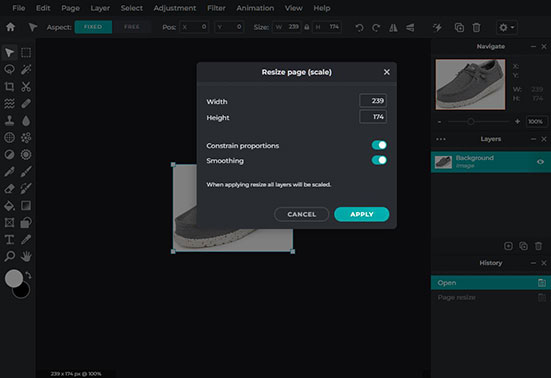
Here is a quick recap of the recommended Amazon product image dimensions:
| Photo Requirement | List Single Items | Book Loader Feeds |
| Minimum Dimensions* | 200 x 200 pixels | One side must be at least 200 pixels but the other may be less |
| Maximum Dimensions* | 2000 x 2000 pixels | 10,000 x 10,000 pixels |
| Maximum Dimension Ratio* | 5 to 1 (2:1 or 1:1 preferred) | 5 to 1 (2:1 or 1:1 preferred) |
Amazon product image template
Canva has an Amazon product image template where you can find inspiration for your images.
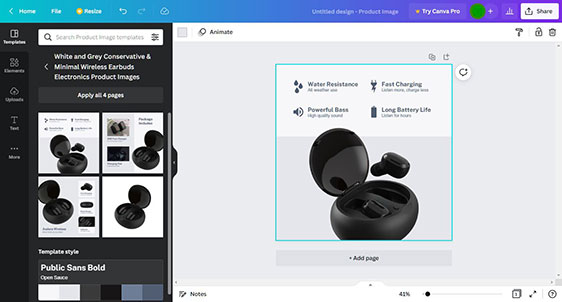
However, this is set to 1080×1080 pixels.
So why the aspect ratio of 1:1 is correct? The size could be bigger, 2000×2000 pixels.
Luckily, you can create custom sizes on Canva as well.
To create a custom size of 2000×2000 pixels, upload your image and position it into the white square provided.
Image Enhancement Through Editing
Image enhancement is vital in improving the quality and appeal of product images on Amazon. By applying appropriate editing techniques, sellers can significantly boost the visual representation of their products, thus increasing their potential to attract customers.
Image Editing
Editing product images often involves adjusting colors, enhancing details, and improving visibility. By ensuring that colors are vibrant and true to life, sellers can create a more accurate representation of their products. This is particularly important for clothing, accessories, and other items where color is a key factor in purchasing. Adjusting colors like brightness, saturation, and contrast can help achieve this goal.
Picture enhancement
Detail enhancement is another crucial aspect of image editing. Ensuring that product images contain clear and sharp details enables potential buyers to examine product features closely. Increasing the sharpness, reducing noise, and applying localized contrast adjustments can preserve and highlight important details.
Amazon photo details
Improving visibility is essential for products with intricate designs or small features. Techniques such as dodging and burning can enhance the visibility of these elements. This enables customers to see all the product components, thus making an informed decision.
Photo quality
High-resolution images offer better clarity and detail, making it easier for customers to inspect and evaluate the product. Amazon recommends using images with a minimum of 1000 pixels on the longest side, ensuring high quality and zoom capability. By exporting and uploading high-resolution images, sellers can create an immersive visual experience for potential buyers.
In conclusion, image enhancement through editing is a crucial aspect of creating compelling product images for Amazon. By employing techniques such as color adjustment, detail enhancement, and improving visibility, sellers can optimize their images to attract more customers and drive sales. At the same time, using high-resolution images will provide a better viewing experience for potential buyers, further increasing the chances of successful transactions.
Amazon Images with Infographics and Graphics
Leveraging infographics and graphics in your Amazon product images can greatly enhance the visual appeal and understanding of the product features. Infographics, which combine text and visuals, succinctly convey crucial information about the product offering. Incorporating graphics can lead to better engagement with potential customers as they scroll through your product listing.
Consider using a variety of color schemes when designing graphics and infographics to catch the attention of your target audience. The selection of cohesive and aesthetically pleasing colors can help emphasize specific features of the product and create a professional look. To further improve the presentation, consider adding frames that complement the images and text, further enriching the overall design.
Text plays a vital role in product images, especially when it comes to infographics. Keep the typography clear and easy to read, ensuring the text is concise, informative, and relevant to the product features. By selecting appropriate font styles and sizes, you can effectively convey significant product details while maintaining the image’s visual quality.
Finally, remember to maintain clarity and simplicity while incorporating graphics, text, and color schemes when crafting infographics for your Amazon product images. Striking the right balance among these elements will make your product images more appealing and help potential customers better understand the benefits of your product offering.
Images for Amazon Free Templates
Finding free templates for Amazon product images is a simple task if you know where to look. There are several websites to help you create stunning visuals for your Amazon listings, each offering a unique selection of templates and designs.
1. Canva™
Canva is a popular choice for Amazon sellers, as it offers a variety of professionally designed templates for Amazon product images, catering to a diverse range of product categories. Users can easily customize the templates using Canva’s intuitive editing tools.
2. Adobe Spark™
Another useful resource is Adobe Spark. The Adobe Spark platform has an Amazon Seller Collection featuring customizable templates to suit your needs. Adobe Spark’s user-friendly interface makes it easy to create eye-catching product images using their selection of templates.
3. Behance™
Behance is a great platform to explore for inspiration, showcasing designs worldwide. By searching for “Amazon product infographic,” you will come across various design concepts that can be utilized as inspiration for your product images.
4. GetStencil™
For those who prefer a straightforward tool with customizable templates, GetStencil offers a wide range of image sizes that fit specifically for Amazon product images. GetStencil’s minimalist designs can enhance your product listings without overwhelming potential buyers.
5. Dribbble™
Lastly, Dribbble is a popular designer platform to showcase their creative work. By searching for “Amazon listing images,” you can find numerous design options that inspire you when creating your Amazon product images.
In summary, multiple resources are available for finding and customizing free templates for Amazon product images. Exploring these platforms allows you to create professional and visually appealing visuals that effectively showcase your products and attract more customers.
Amazon Image Policy: Chapter 4

Here, we will cover certain topics that are asked often.
If you haven’t found the answer about your product photos in the previous parts, look around below.
Amazon’s image policy is very important for sellers.
Now, let’s see those questions.
Can I put my logo on Amazon pictures?
You must not put any text, logos, or graphics on your main image.

But you could put it on your secondary images.

However, you also have the option to upload the logo on your listing in Sellers Central. Select the ‘Your Info & Policies’ link from ‘Settings’. Click ‘Profile’ on the ‘Your Information & Policies’ page. Locate the ‘Seller Logo’ section, and click the upload button.
Ensure your logo image size is 120 by 30 pixels and the file size is a maximum of 2MB.
Can I use Google images for Amazon listings?
No, this will not be allowed.
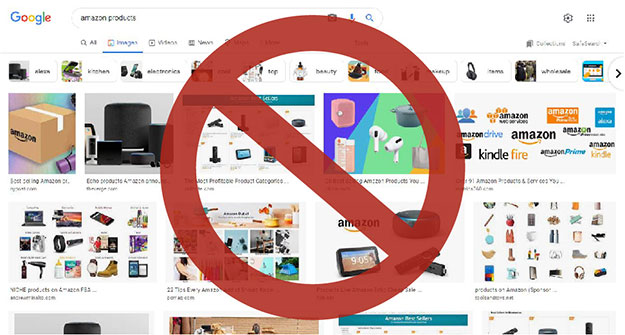
I recommend using your own photos for your listings.
This is the most foolproof way to sell.
Can I use Alibaba pictures on Amazon?
Yes, you can use Alibaba pictures on Amazon.
You must ask for permission from your supplier.
While this is allowed, it is not recommended for the following reasons:
- Some of the Alibaba pictures are low-quality
- They might be copied from other sellers/suppliers
- These images won’t necessarily comply with Amazon product image policies.
I would always recommend using unique, original, and professional pictures for your product listings.
Set your standards high, and avoid shortcuts, as Amazon is a highly competitive market.
Can I use other sellers’ pictures on Amazon?
Technically, yes. When you upload a picture to Amazon, you permit them to use it on their site.
This means that other sellers can also use it for the same product.
However, you can’t use other sellers’ pictures on a different site from Amazon, which breaches copyright.
Who owns Amazon images?
Amazon owns the images on its website.
If you upload your product images to Amazon, you permit them to use them.
Can I post Amazon images on Instagram?
If you’re referring to product images from Amazon listings, it’s essential to be cautious. Those images are typically copyrighted, and using them without permission could lead to copyright infringement. If it’s your product and your image (and you have the rights to it), then you can post it. If not, you should obtain permission from the copyright holder before posting on Instagram or any other platform.
How to Boost Sales with Effective Product Images?
Utilizing effective Amazon product images can significantly impact sales, conversion rates, and click-through rates. By creating high-quality images that appeal to the target audience, potential customers are more likely to show interest in the product, increasing overall conversions.
To achieve this, it’s important to focus on a few best practices. First, ensure that the main product image is clear and professionally taken. This image is often the first impression potential customers have when browsing Amazon and can greatly influence the conversion rate. Consistently use high-resolution images with a 1:1 to 1.5:1 aspect ratio and a minimum of 1000 pixels on the longest side.
Second, consider incorporating lifestyle and infographic images into the product listing gallery. Amazon allows one infographic or lifestyle image per listing. These images can help customers understand the product’s features and benefits, providing context for how the product may be used in real-life scenarios. This can be particularly helpful for demonstrating the effectiveness or suitability of a product.
Moreover, visual elements such as tables, bullet points, and bold text within the product images can help convey important information more effectively and efficiently. For instance, a bullet-point list of key features can quickly highlight the product’s value proposition, while a table comparing different product variations can aid customers in choosing the right option for their needs.
In summary, by optimizing product images on Amazon, sellers can appeal to their target audience, increasing click-through rates and conversions. Focusing on professional, high-quality images, incorporating lifestyle or infographic images, and employing visual elements like tables and bullet points can greatly enhance product listings and ultimately contribute to higher sales on Amazon.
How to Increase Brand Visibility Through Product Images?
In the competitive online retail world, properly optimized product images on your Amazon listing are of utmost importance to increase product visibility. A strong set of images not only enhances the attractiveness of your brand but also helps build customer trust, ultimately leading to increased sales.
To achieve a compelling visual presentation, follow Amazon Image Requirements. Ensure that your images are at least 1000 pixels on the longest side and maintain an aspect ratio between 1:1 and 1.5:1. Adhering to these guidelines will ensure your images are clear, vivid, and informative for potential buyers.
Incorporating your brand’s logo and packaging into the product images is essential to boost your brand identity. Logos should be prominently displayed on the product itself or as a watermark while still complying with Amazon’s guidelines. Showcasing your captivating packaging within the images can help distinguish your products from competitors and assure buyers of the item’s quality.
A valuable tactic for Amazon sellers is highlighting their products’ unique features and benefits through informative infographics or lifestyle images. These images can illustrate specific details or demonstrate how a product can be utilized in everyday life, answering any potential customer questions. However, Amazon must allow only one infographic or lifestyle image in the product listing gallery.
Consider implementing Amazon SEO techniques to further optimize your product images for brand visibility. Integrating relevant keywords into the image file names, image alt text, and image descriptions can significantly improve your search rankings on the platform.
With these strategies in place, your product images will appeal to potential customers visually and contribute to your brand’s overall success in Amazon’s marketplace.
Photo Optimizing for E-Commerce
Optimizing product images is a crucial aspect of e-commerce success. High-quality images can increase conversions and set your business apart from competitors. To optimize your images for e-commerce, follow these recommendations.
First, ensure that your images meet the technical requirements of the platform. For example, Amazon requires that images be JPEG, TIFF, PNG, or GIF formats, with JPEG being the preferred option. Images should be high-quality, crisp, and free of blurriness, pixelation, or jagged edges.
Creating eye-catching images involves paying special attention to color and lighting. The accurate representation of colors not only attracts customers but also reduces returns due to color discrepancies. Remember that different devices and screens may display colors differently, so calibrate your images to ensure consistency.
Focus on framing your products correctly. Fill most of the frame with the product, ensuring it will be clearly visible on various devices, including smartphones and tablets. Use simple, uncluttered backgrounds to make your product stand out. Incorporating the product’s environment or context can help customers visualize how it will fit into their lives.
Multiple images for each product listing can effectively showcase different angles, details, and features. This targeted approach allows customers to understand the product comprehensively and can lead to higher conversion rates.
When selecting images, prioritize those that highlight the most desirable features of the product. Consider including images that demonstrate the product in use, as this can help to address common questions or concerns. To make your listings more engaging, include infographics or images with text overlays highlighting key information or benefits.
By optimizing product images for e-commerce, businesses can present their products in the best possible light. This will not only create a more enjoyable shopping experience for customers but also give your brand an edge in the competitive world of online retail.
Amazon Image Requirements FAQ
What are the image requirements for Amazon products in 2023?
Amazon has specific image requirements for product listings. The main requirements include using a pure white background (RGB 255,255,255), filling 85% or more of the image frame with the product, and ensuring the entire product is within the frame. For books, music, and video/DVD products, the front cover art should fill 100% of the image frame.
What is the ideal resolution for Amazon product images?
The ideal resolution for Amazon product images is at least 1000 pixels on the longest side, enabling the zoom function on the product page. If your image is smaller, try to ensure that it is at least 500 pixels on the longest side. Higher resolutions can provide better image clarity and improve the customer experience.
How to achieve the best Amazon product images?
To achieve the best Amazon product images, ensure you meet the technical Amazon image requirements, use professional photography or high-quality photo editing, and provide a variety of images, including lifestyle and infographic images. Showcasing different angles and uses of your product can help give customers a better understanding of the item.
What is the maximum size (MB) allowed for Amazon product images?
The maximum file size allowed for Amazon product images is 10 MB. It’s essential to optimize your images for file size and quality to ensure that they load quickly on the product listing page while providing valuable visual information for potential customers.
What is the recommended aspect ratio for Amazon product images?
Amazon product images should have an aspect ratio between 1:1 and 1.5:1. This aspect ratio ensures a consistent and visually appealing appearance across various devices and listing layouts and helps shoppers compare and evaluate products more easily.
How to utilize Amazon product image templates for better photography?
Utilizing Amazon product image templates can help you achieve a consistent and professional look in your images. You can find templates online or create custom ones that follow Amazon guidelines and provide space for essential product information, such as dimensions, features, and instructions. Adhering to these templates can improve the quality of your product images and enhance the customer experience.
How do I get pictures for my Amazon product?
To get pictures for your Amazon product, you can either hire a professional product photographer or take the photos yourself using a high-quality camera. If you decide to do it yourself, ensure you follow Amazon’s guidelines, including using a white background, ensuring the product takes up at least 85% of the image, and maintaining high resolution. Remember, high-quality images can significantly impact your sales on Amazon.
What are the image requirements for Amazon?
Amazon’s primary image requirements include:
- A pure white background (RGB 255,255,255).
- The product should fill at least 85% of the image.
- Images should be at least 1000 pixels on the longest side for zoom capability.
- Accepted file formats are JPEG, TIFF, PNG, and GIF.
- The maximum file size is 10MB.
Does Amazon accept PNG?
Yes, Amazon accepts the PNG file format for product images, along with JPEG, TIFF, and GIF.
What is the best image size for Amazon?
The optimal image size for Amazon is 2000×2000 pixels with a 1:1 aspect ratio, as this allows for maximum zoom.
Can I use stock photos on Amazon?
No, you cannot use stock photos on Amazon for your main product images. Main product images should accurately represent the actual product you are selling. Using stock photos can lead to misleading the customer and may result in suspending your listing. However, there may be more flexibility for secondary images, such as those in A+ content.
Does Amazon accept JPEG?
Yes, Amazon accepts JPEG (.jpeg or .jpg) as a file format for product images.
Does Amazon accept JPG?
Yes, Amazon accepts JPG (.jpg), essentially the same as JPEG.
What is Amazon A+ content?
Amazon A+ content allows brand owners to enhance their product listings with rich visuals and additional text placements to overcome purchase hesitations and drive brand affinity. This premium content can include images, comparison charts, videos, and more, and it’s designed to boost conversions, increase traffic, and provide a better customer experience.
Which image size is best?
The best image size largely depends on the platform and use case. For Amazon product listings, an optimal size is 2000×2000 pixels. Generally, images should be optimized for visual clarity and file size for web usage to ensure quick page load times.
What size is Amazon custom image?
For custom images on Amazon, it’s best to follow the guideline of at least 1000 pixels on the longest side for zoom capability, but ideally 2000×2000 pixels for maximum zoom and clarity.
What does Amazon do with my photos?
Amazon uses your photos to represent your product on its listing page. Proper images help customers understand what they’re purchasing. Amazon stores these images on its servers, used across the platform wherever the product appears.
Is Amazon PNG or JPG?
Amazon accepts PNG and JPG (as well as TIFF and GIF) for product images. However, JPG is often recommended due to its typically smaller file size and sufficient quality for e-commerce photos.
What file type does Amazon accept?
For product images, Amazon accepts JPEG (.jpg or .jpeg), PNG (.png), TIFF (.tif), and GIF (.gif) file formats.
What file format does Amazon accept?
Amazon primarily accepts JPEG, PNG, TIFF, and GIF file formats for product images. However, depending on the specific Amazon service (like Amazon A+ content or videos), there may be other specific format requirements.
How many images can you have on Amazon?
You can upload up to 9 images for most product listings on Amazon. This includes one main image and up to 8 additional images. However, the exact number might vary based on the product category or specific seller account limitations.
Can you use Shutterstock images on Amazon?
No, you can not use Shutterstock images. Amazon requires that the main product image accurately represents the product being sold and should not be misleading. Stock images can often be generic and may not accurately represent the specific product you’re selling. However, for secondary images or A+ content where you might be illustrating a concept, using stock images might be acceptable as long as you have the appropriate license for commercial use. Always abide by Shutterstock’s (or any stock image provider’s) licensing terms.
What is the minimum image size for Amazon?
The minimum image size for Amazon product listings is 500 pixels on the longest side, but it’s recommended to have an image size of at least 1000 pixels on the longest side to enable the zoom function. For optimal zoom, an image size of 2000×2000 pixels is ideal. Always ensure your images are high quality and meet other Amazon image requirements.
How can Amazon sellers optimize images with automation?
To ensure compliance with Amazon’s image requirements for private label products, it’s advisable to use automation tools to format images in the right format, compatible across various browsers, reducing the risk of non-compliance. For dropshipping businesses, it’s essential to regularly experiment with image styles based on customer feedback, which can be efficiently gathered through email surveys, ensuring that the inventory presentation aligns with consumer preferences.
Where else can Amazon image requirements compliant photos be used?
Amazon’s high-quality product images are also suitable for Walmart, eBay, Etsy, and e-commerce platforms like Shopify, BigCommerce, and WooCommerce.
In case you find anything missing from the faqs or have any questions about the Amazon image requirements? Please leave a comment below.
Denes, with 20 years experience in logistics, holds a Logistics Manager degree from Budapest’s Logistics Association and has penned a thesis on mobile devices. Venturing into e-commerce, Denes specializes in Fulfilled By Amazon and passionately educates others about Amazon selling techniques.
3 Comments
Leave a CommentWould you recommend hiring a professional or taking the pictures for yourself?
It depends on your budget, but I highly suggest hiring a professional.
Buyers make a decision by looking at the images of your product.
Although if you have the talent, and good quality gear (camera, lighting, background) you may do it yourself of course.
Amazing blog!
Very nice explained about associated factors with the Amazon product photographs and basics of image requirements. White background is important for Amazon images.
Comments are closed.